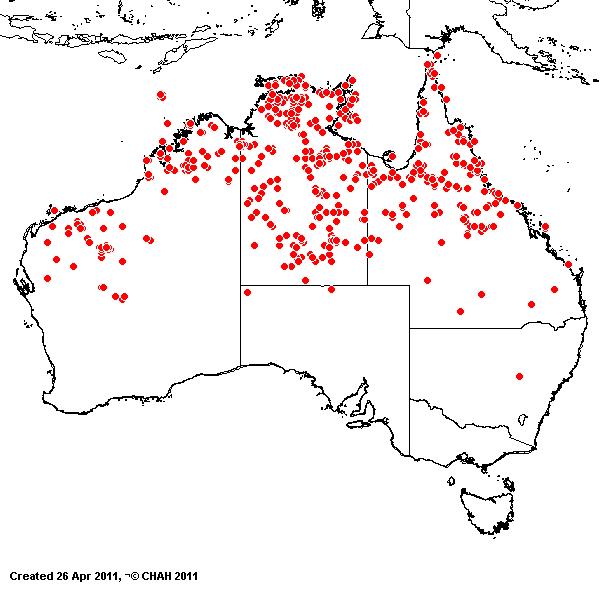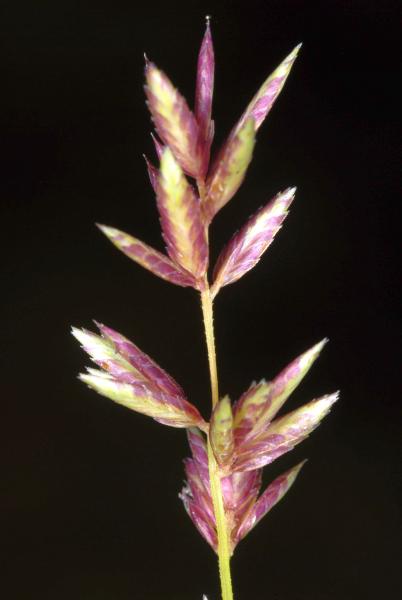Eragrostis cumingii Steud. Syn.
Pl. Gram. 1: 266 (1854).
Classification. (GPWG 2001) : Subfamily Chloridoideae. Cynodonteae.
Type of Basionym or
Protologue Information: Philippine Islands: Luzon:
Laguna, 1841, Cuming 672 (HT: ?; ST: L, LE) and 1104.
Recent synonyms: E. bleeseri, E. distans.
Key references
(books and floras): [1969] E.E.Henty, Manual Grasses New Guinea
(93), [1981] M.Lazarides in J.Jessop (ed)., Flora of Central Australia
(459), [2002] D.Sharp & B.K.Simon, AusGrass, Grasses of Australia.
Illustrations:
[2005] K.Mallet (ed.), Flora of Australia 44B: Poaceae 3
(Fig. 64M-N, Fig. 72BB-CC).
Habit. Annual
or perennial. Culms erect or decumbent or sprawling, 3–100 cm tall, wiry.
Leaf-sheaths glabrous on surface. Ligule a fringe of hairs, 0.3 mm long.
Leaf-blades straight, filiform, flat or involute or convolute, 5–10 cm long,
1–3.5 mm wide.
Inflorescence.
Inflorescence compound, a panicle. Panicle elliptic, 4.5–73 cm long, 2–4 cm
wide, with spikelets clumped along branches.
Spikelets.
Spikelets pedicelled. Fertile spikelets many flowered, with at least 2 fertile
florets (10–20(-88)), comprising 10–20(–88) fertile floret(s), with diminished
florets at the apex, linear or lanceolate or oblong or ovate, laterally
compressed, 4–15 mm long.
Glumes. Glumes
similar. Lower glume lanceolate, membranous, keeled, 1-keeled, 1 -nerved. Upper
glume ovate, 1.3–3 mm long, membranous, keeled, 1-keeled, 3 -nerved.
Florets. Fertile
lemma 1.5–2.6 mm long, keeled, 3 -nerved. Lemma apex muticous or mucronate.
Lodicules present. Anthers 2–3. Grain 4 mm long.
Continental
Distribution: Temperate Asia, Tropical Asia, Australasia, North America,
and South America.
Australian
Distribution: Western Australia, Northern Territory, Queensland.
Western
Australia: Gardner.
Canning. Northern Territory: Darwin
& Gulf, Barkly Tableland, Central Australia North, Central
Australia South. Queensland:
Burke, Cook, Gregory North, North Kennedy, Port Curtis, South Kennedy, Gregory
South, Mitchell, Warrego, Maranoa, Burnett.
Notes.
Distinguishing characters include annual habit; gibbous lemmas; thickened
straight, semi-persistent rachilla; palea keels with thickened, unequal and
relatively long (visible in situ) hairs; strongly compressed caryopsis;
terminal and axillary panicles; short paleas relative to lemmas; incurved lemma
margins.
A polymorphic, cleistogamous species, plants
vary highly in dimensions, branching habit and panicle structure, which accounts
for its extensive synonymy. Though strictly annual, it has been confused with
the perennials, E. spartinoides and E. zeylanica. In Australia, the
species extends into arid regions, where the common xerophytic form produces
numerous axillary clusters of spikelets and intergrades with E. basdowii,
an Australian arid endemic. In contrast, the typical Australian monsoonal
plant, described as E. bleeseri, produces only large usually spreading
terminal inflorescences.
Native;
widespread across northern and central Australia.; E. cumingii is native
from Taiwan, through Burma and Malesia to Australia. It occurs also as a weed
in Florida, U.S.A. Widespread in seasonally wet, sometimes saline sites (viz.
floodplains, swamps lakes, seepage slopes, depressions, and beds, banks and
levees of watercourses); in deep often alluvial sands, clays loams and
podsolics, or in shallow soils over limestone, granite laterite, sandstone and
volcanics; smetimes on coastal sand dunes and shell ridges.; flowers all year
round.; fruits all year round.








